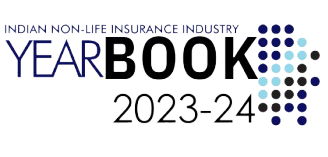The yearbook 2023-2024 has been developed to present a comprehensive analysis of the Indian Non-Life Insurance Market to the stakeholders in the industry, keeping with the traditions of the previous year’s yearbooks.
Each chapter of the yearbook has been specifically organized to focus on different aspects of the Indian non-life insurance industry. Covering macro-economic and insurance indicators, state-wise penetration and density, Industry Business Highlights, Segmentwise Business Highlights, Underwriting results, Customer Service and Reinsurance. The annexures include data tables and information on the working of the companies.
The Yearbook has been developed with sources of data available within the GI Council, Non-life Insurance Industry players, and the Regulator. Economic data has been sourced from RBI and various government sources.
A close study of the performance since 2014-15 discloses that the Non-Life Insurance Insurers have maintained steady growth in all facets of performance over the years. Economic growth of the country, expansion of the associated industries, increasing purchasing power of the middle-class, a growing young working population, increase in number of vehicles, better infrastructure, growth in health awareness and preventive healthcare are encouraging indicators for the Non-Life Insurance industry for a positive future trend.
The Yearbook also highlights the status of Non-life Insurance penetration in the country in the form of heat maps and gives claims data state-wise. The heat maps show a panoramic view of how the Non-Life Insurance penetration has improved during the last 10 years. Additionally, a brief summary of the key findings of each section’s investigation is included in every chapter.
The salient features of the non-life industry for the year 2023-24 were:
- The current fiscal year 2023-24 experienced a GDPI growth of 12.40%.
- In terms of distribution, brokers have emerged as the largest contributors to GDPI, with their business growing at a faster pace in recent years compared to other major channels such as Agents and Direct sales.
- Health and Personal Accident insurance premiums have experienced significant growth this year, emerging as the leading contributors to GDPI from a product perspective.
- Recruitment has started increasing again, the total employee number in 2023-24 stands at 179,207. The industry absorbed 16,301 new personnel in the current fiscal year.
- The industry has increasingly invested in the social and infrastructure sector over the last decade. This year the amount invested is ₹ 1,06,359 Cr.
Key parameters and comparisons:
Macro-economic:
- Insurance penetration (as a percentage) at current prices rose from 0.68 in 2014-15 to 0.98 in 2023-24. It increased consistently from 2014-15 to 2020-21, surpassing the 1% mark in 2020-21, but experienced a decline in 2021-22.
- Insurance density nearly tripled from ₹ 657 in 2014-15 to ₹ 2,009 in 2023-24. This year, it climbed from ₹ 1,798 recorded the previous year.
Industry Growth and Capital Leverage:
- Gross Direct Premium Income (GDPI) in India has increased from ₹ 84,686 Crores in 2014-15 to ₹ 2,89,673 Crores in 2023-24.
- The Yield on Investment stands at 8.94%, reflecting a slight decrease of 0.30% compared to the previous year.
- Capital employed has increased from ₹ 48,774 Crores in 2014-15 to ₹ 1,04,279 Crores in 2023-24, while Investments have almost quadrupled from ₹ 1,39,887 Crores in 2014-15 to ₹ 5,18,759 Crores in 2023-24.
Operational Parameters
- Number of Insurance offices increased from 2014-15 till 2018-19, after that the growth plateaued. In 2023-24, the number of offices rose to 10,376, up from 9,928 in 2022-23.
- Number of policies issued has increased from 12.60 Crores in 2014-15 to 33.40 Crores in 2023-24. The growth has been 10.50% over the previous year.
- Overall net retention ratio has decreased slightly from 73.9% in FY 22-23 to 73.4% in FY 23-24.
Class – Mix
- Health and accident insurance accounts for the highest share of GDPI at 40.3% increase from 38.0% of the previous year, closely followed by Motor Insurance at 31.7%. Health and accident segment has also been growing at the highest rate, with a CAGR of 19.5% over the period 2014-15 to 2023-24. Crop insurance is also an important segment contributing majority premiums in Other Misc.
- In the fiscal year 2023–24, the Gross Incurred Claims ratio stood at 73.0%, while the Net Incurred Claims ratio reached 82.50%.
Underwriting Results
- Underwriting deficit has increased this year, reversing the trend of the last three years, with the increase in claims. It is (₹ 28,587) Cr in 2023-24 from (₹ 33,154) Cr of the previous year.
- Specialised Insurers showed successful underwriting results in FY 2023–2024. Thus, specialised insurance has experienced growth. and profitability.
- There was an overall profit (after tax) for the industry for the current financial year amounting to ₹ 10,664 Cr as compared to profit after tax of (₹ 1,949) Cr in the previous year.
Conclusion
In conclusion, the Non-Life Insurance industry continues to show maturity and resilience over the last 10 years despite facing many operational challenges, since the removal of tariffs. The industry players are well poised to take advantage of the favorable business climate emerging from various Government initiatives to tap the huge untapped potential in the Indian markets in the years to come. The Industry will continue to become a more important part of the Country’s economic and social fabric. With Government initiatives in various sectors, the Industry seeks to create value and tap potential with increasingly better reach, technology, infrastructure, education and awareness.

